Conflict and Negotiation in Managing People and Organization Report
VerifiedAdded on 2020/05/28
|14
|3169
|57
Report
AI Summary
This report provides a comprehensive literature review on conflict and negotiation in the workplace. It explores the concept of conflict, various factors affecting it, and different types of conflicts, including functional, dysfunctional, task, relationship, and process conflicts. The report delves into Karl Marx's theory of conflict and the Thomas Kilmann model of conflict resolution, outlining methods for conflict management. It also covers the concept of negotiation, its affecting factors, and the phases involved. The report includes a self-assessment using the Johari Window, Thomas Kilmann Questionnaire, and The Big 5 Personality Test to identify strengths and weaknesses related to conflict management and negotiation styles. Based on these assessments, the report offers recommendations for improvement, particularly focusing on addressing competitive and neurotic tendencies, and concludes with a summary of key findings.
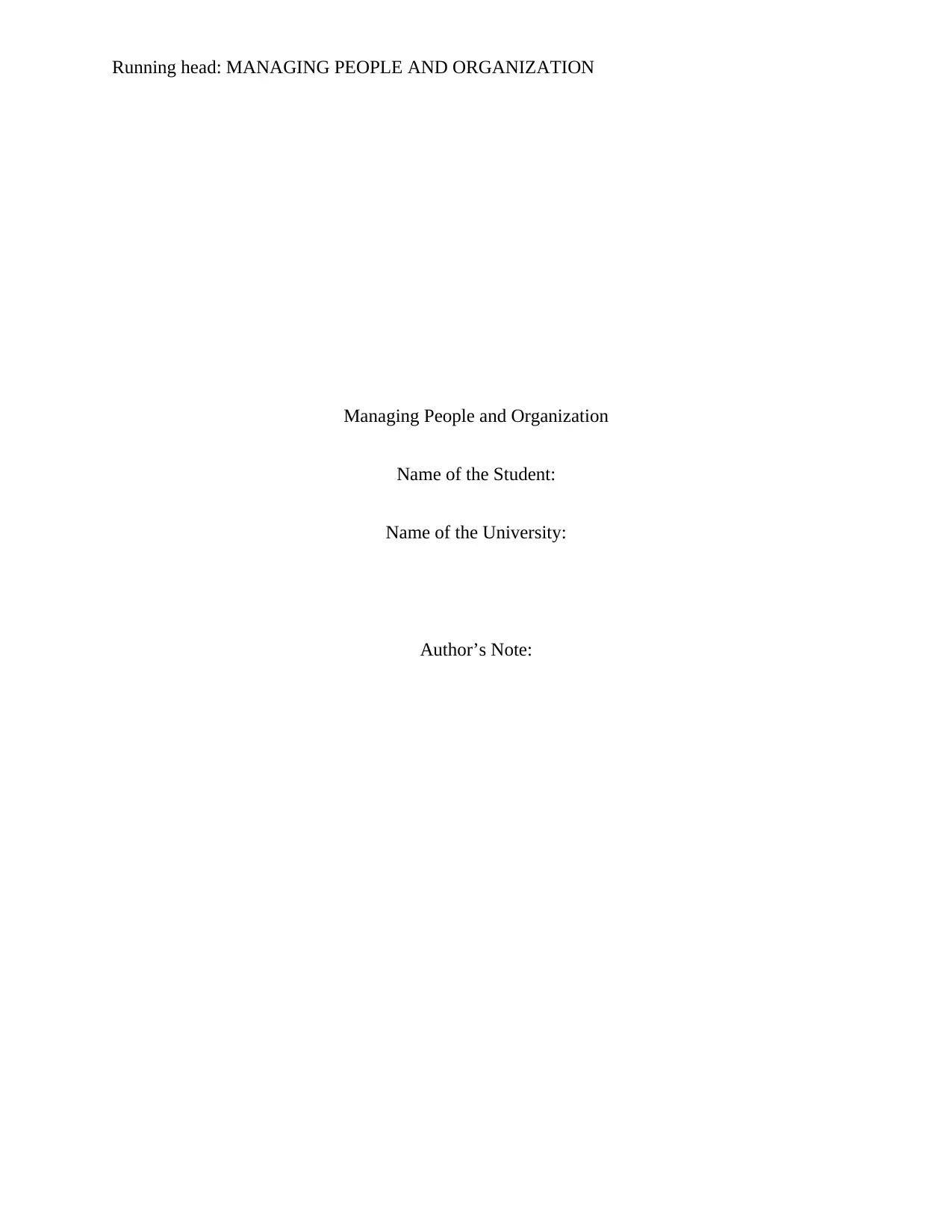
Running head: MANAGING PEOPLE AND ORGANIZATION
Managing People and Organization
Name of the Student:
Name of the University:
Author’s Note:
Managing People and Organization
Name of the Student:
Name of the University:
Author’s Note:
Paraphrase This Document
Need a fresh take? Get an instant paraphrase of this document with our AI Paraphraser
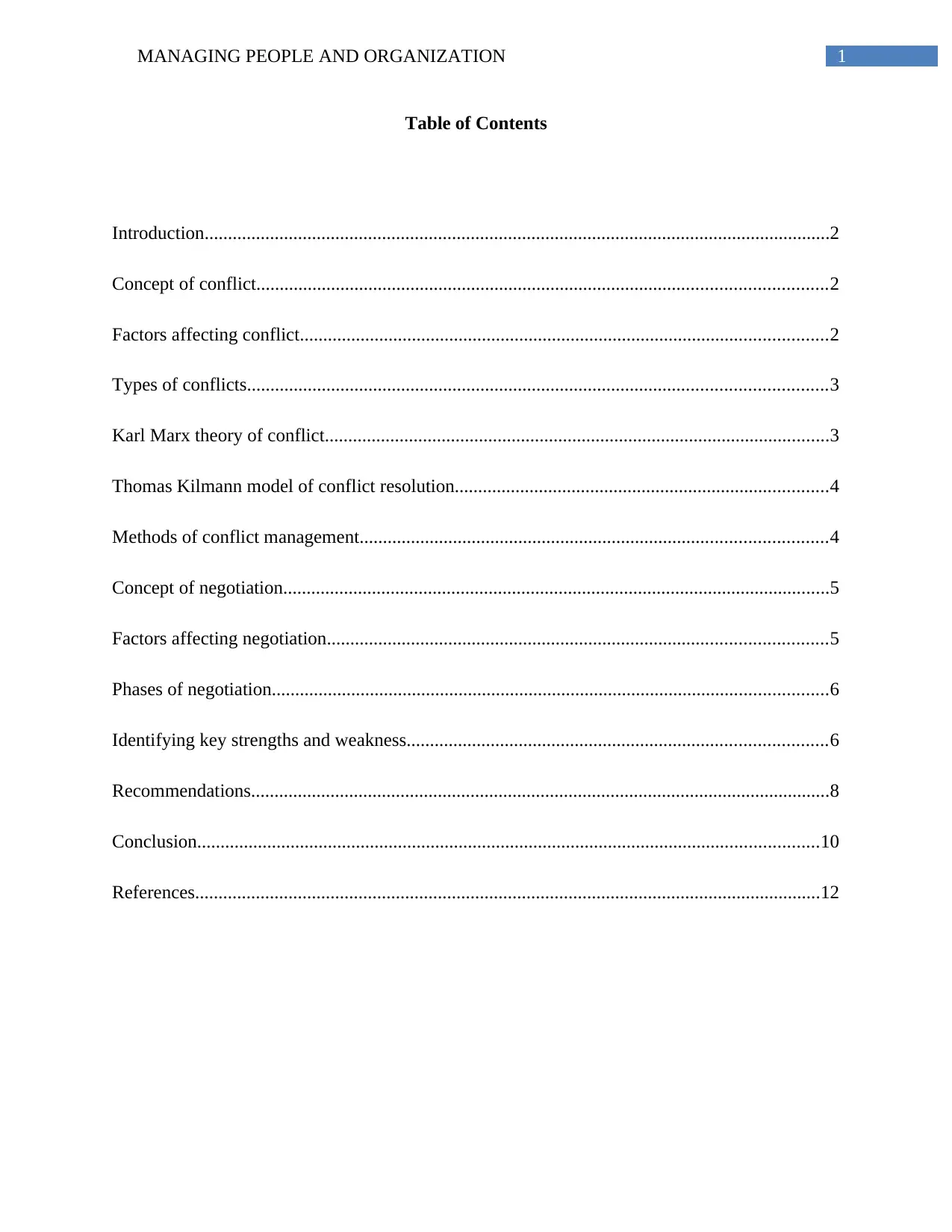
1MANAGING PEOPLE AND ORGANIZATION
Table of Contents
Introduction......................................................................................................................................2
Concept of conflict..........................................................................................................................2
Factors affecting conflict.................................................................................................................2
Types of conflicts............................................................................................................................3
Karl Marx theory of conflict............................................................................................................3
Thomas Kilmann model of conflict resolution................................................................................4
Methods of conflict management....................................................................................................4
Concept of negotiation.....................................................................................................................5
Factors affecting negotiation...........................................................................................................5
Phases of negotiation.......................................................................................................................6
Identifying key strengths and weakness..........................................................................................6
Recommendations............................................................................................................................8
Conclusion.....................................................................................................................................10
References......................................................................................................................................12
Table of Contents
Introduction......................................................................................................................................2
Concept of conflict..........................................................................................................................2
Factors affecting conflict.................................................................................................................2
Types of conflicts............................................................................................................................3
Karl Marx theory of conflict............................................................................................................3
Thomas Kilmann model of conflict resolution................................................................................4
Methods of conflict management....................................................................................................4
Concept of negotiation.....................................................................................................................5
Factors affecting negotiation...........................................................................................................5
Phases of negotiation.......................................................................................................................6
Identifying key strengths and weakness..........................................................................................6
Recommendations............................................................................................................................8
Conclusion.....................................................................................................................................10
References......................................................................................................................................12
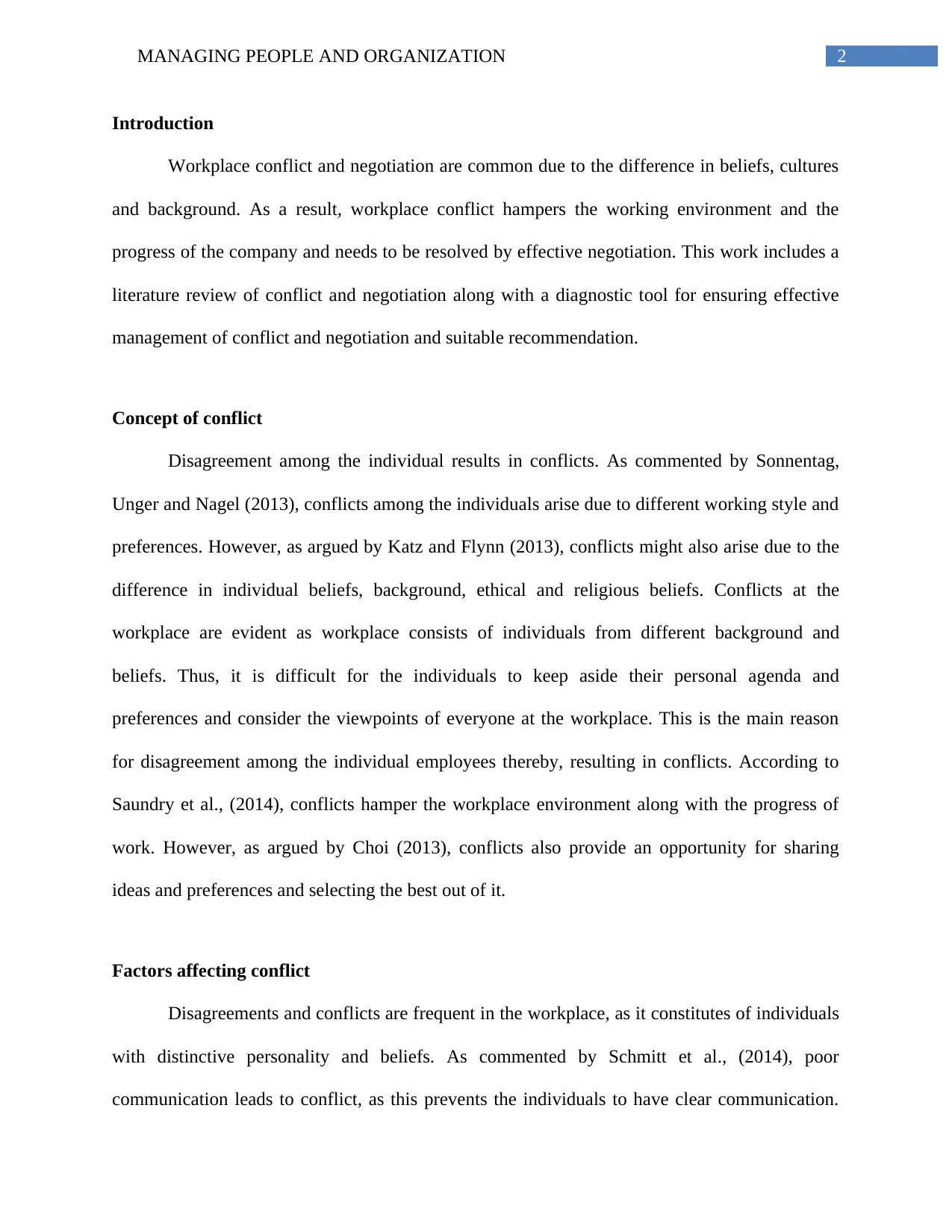
2MANAGING PEOPLE AND ORGANIZATION
Introduction
Workplace conflict and negotiation are common due to the difference in beliefs, cultures
and background. As a result, workplace conflict hampers the working environment and the
progress of the company and needs to be resolved by effective negotiation. This work includes a
literature review of conflict and negotiation along with a diagnostic tool for ensuring effective
management of conflict and negotiation and suitable recommendation.
Concept of conflict
Disagreement among the individual results in conflicts. As commented by Sonnentag,
Unger and Nagel (2013), conflicts among the individuals arise due to different working style and
preferences. However, as argued by Katz and Flynn (2013), conflicts might also arise due to the
difference in individual beliefs, background, ethical and religious beliefs. Conflicts at the
workplace are evident as workplace consists of individuals from different background and
beliefs. Thus, it is difficult for the individuals to keep aside their personal agenda and
preferences and consider the viewpoints of everyone at the workplace. This is the main reason
for disagreement among the individual employees thereby, resulting in conflicts. According to
Saundry et al., (2014), conflicts hamper the workplace environment along with the progress of
work. However, as argued by Choi (2013), conflicts also provide an opportunity for sharing
ideas and preferences and selecting the best out of it.
Factors affecting conflict
Disagreements and conflicts are frequent in the workplace, as it constitutes of individuals
with distinctive personality and beliefs. As commented by Schmitt et al., (2014), poor
communication leads to conflict, as this prevents the individuals to have clear communication.
Introduction
Workplace conflict and negotiation are common due to the difference in beliefs, cultures
and background. As a result, workplace conflict hampers the working environment and the
progress of the company and needs to be resolved by effective negotiation. This work includes a
literature review of conflict and negotiation along with a diagnostic tool for ensuring effective
management of conflict and negotiation and suitable recommendation.
Concept of conflict
Disagreement among the individual results in conflicts. As commented by Sonnentag,
Unger and Nagel (2013), conflicts among the individuals arise due to different working style and
preferences. However, as argued by Katz and Flynn (2013), conflicts might also arise due to the
difference in individual beliefs, background, ethical and religious beliefs. Conflicts at the
workplace are evident as workplace consists of individuals from different background and
beliefs. Thus, it is difficult for the individuals to keep aside their personal agenda and
preferences and consider the viewpoints of everyone at the workplace. This is the main reason
for disagreement among the individual employees thereby, resulting in conflicts. According to
Saundry et al., (2014), conflicts hamper the workplace environment along with the progress of
work. However, as argued by Choi (2013), conflicts also provide an opportunity for sharing
ideas and preferences and selecting the best out of it.
Factors affecting conflict
Disagreements and conflicts are frequent in the workplace, as it constitutes of individuals
with distinctive personality and beliefs. As commented by Schmitt et al., (2014), poor
communication leads to conflict, as this prevents the individuals to have clear communication.
⊘ This is a preview!⊘
Do you want full access?
Subscribe today to unlock all pages.

Trusted by 1+ million students worldwide
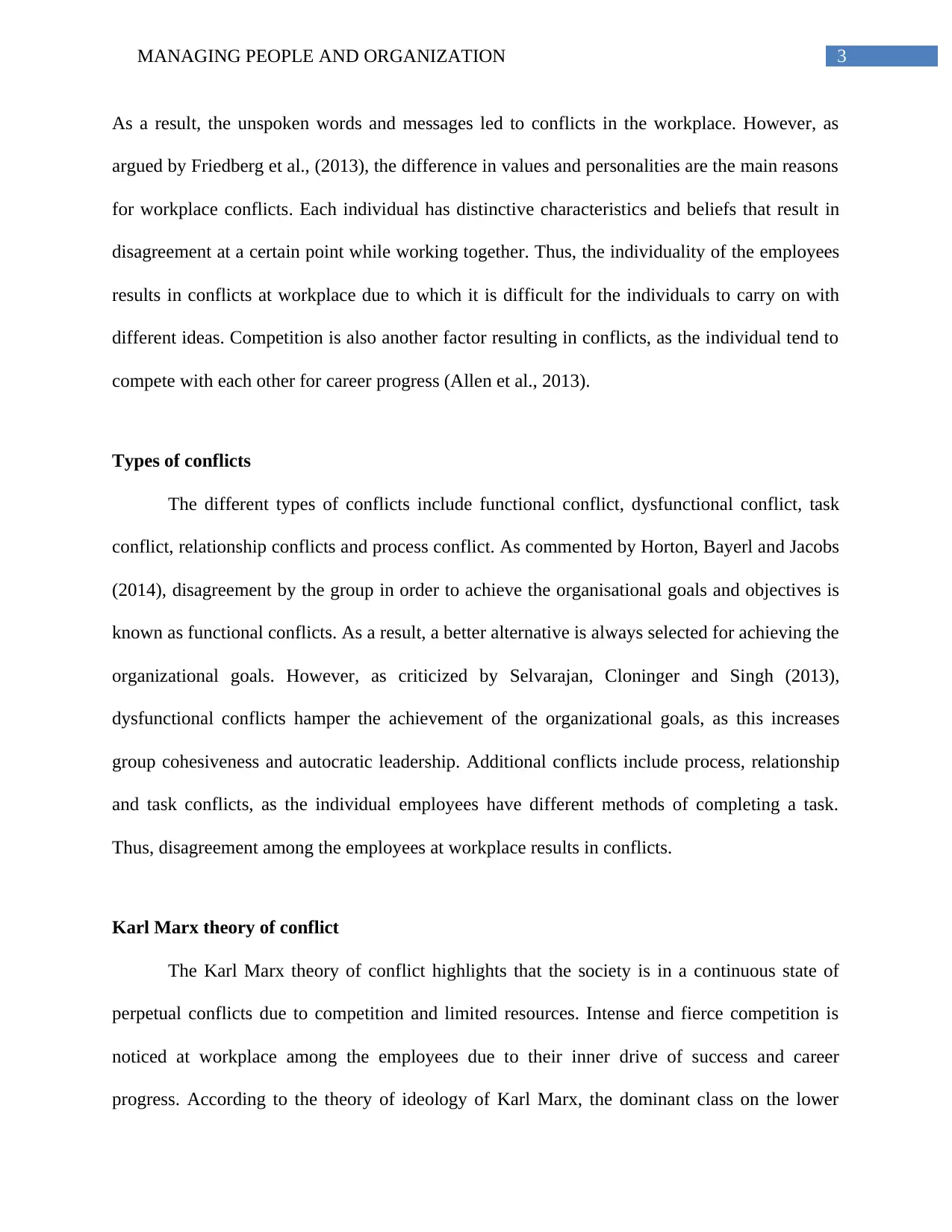
3MANAGING PEOPLE AND ORGANIZATION
As a result, the unspoken words and messages led to conflicts in the workplace. However, as
argued by Friedberg et al., (2013), the difference in values and personalities are the main reasons
for workplace conflicts. Each individual has distinctive characteristics and beliefs that result in
disagreement at a certain point while working together. Thus, the individuality of the employees
results in conflicts at workplace due to which it is difficult for the individuals to carry on with
different ideas. Competition is also another factor resulting in conflicts, as the individual tend to
compete with each other for career progress (Allen et al., 2013).
Types of conflicts
The different types of conflicts include functional conflict, dysfunctional conflict, task
conflict, relationship conflicts and process conflict. As commented by Horton, Bayerl and Jacobs
(2014), disagreement by the group in order to achieve the organisational goals and objectives is
known as functional conflicts. As a result, a better alternative is always selected for achieving the
organizational goals. However, as criticized by Selvarajan, Cloninger and Singh (2013),
dysfunctional conflicts hamper the achievement of the organizational goals, as this increases
group cohesiveness and autocratic leadership. Additional conflicts include process, relationship
and task conflicts, as the individual employees have different methods of completing a task.
Thus, disagreement among the employees at workplace results in conflicts.
Karl Marx theory of conflict
The Karl Marx theory of conflict highlights that the society is in a continuous state of
perpetual conflicts due to competition and limited resources. Intense and fierce competition is
noticed at workplace among the employees due to their inner drive of success and career
progress. According to the theory of ideology of Karl Marx, the dominant class on the lower
As a result, the unspoken words and messages led to conflicts in the workplace. However, as
argued by Friedberg et al., (2013), the difference in values and personalities are the main reasons
for workplace conflicts. Each individual has distinctive characteristics and beliefs that result in
disagreement at a certain point while working together. Thus, the individuality of the employees
results in conflicts at workplace due to which it is difficult for the individuals to carry on with
different ideas. Competition is also another factor resulting in conflicts, as the individual tend to
compete with each other for career progress (Allen et al., 2013).
Types of conflicts
The different types of conflicts include functional conflict, dysfunctional conflict, task
conflict, relationship conflicts and process conflict. As commented by Horton, Bayerl and Jacobs
(2014), disagreement by the group in order to achieve the organisational goals and objectives is
known as functional conflicts. As a result, a better alternative is always selected for achieving the
organizational goals. However, as criticized by Selvarajan, Cloninger and Singh (2013),
dysfunctional conflicts hamper the achievement of the organizational goals, as this increases
group cohesiveness and autocratic leadership. Additional conflicts include process, relationship
and task conflicts, as the individual employees have different methods of completing a task.
Thus, disagreement among the employees at workplace results in conflicts.
Karl Marx theory of conflict
The Karl Marx theory of conflict highlights that the society is in a continuous state of
perpetual conflicts due to competition and limited resources. Intense and fierce competition is
noticed at workplace among the employees due to their inner drive of success and career
progress. According to the theory of ideology of Karl Marx, the dominant class on the lower
Paraphrase This Document
Need a fresh take? Get an instant paraphrase of this document with our AI Paraphraser
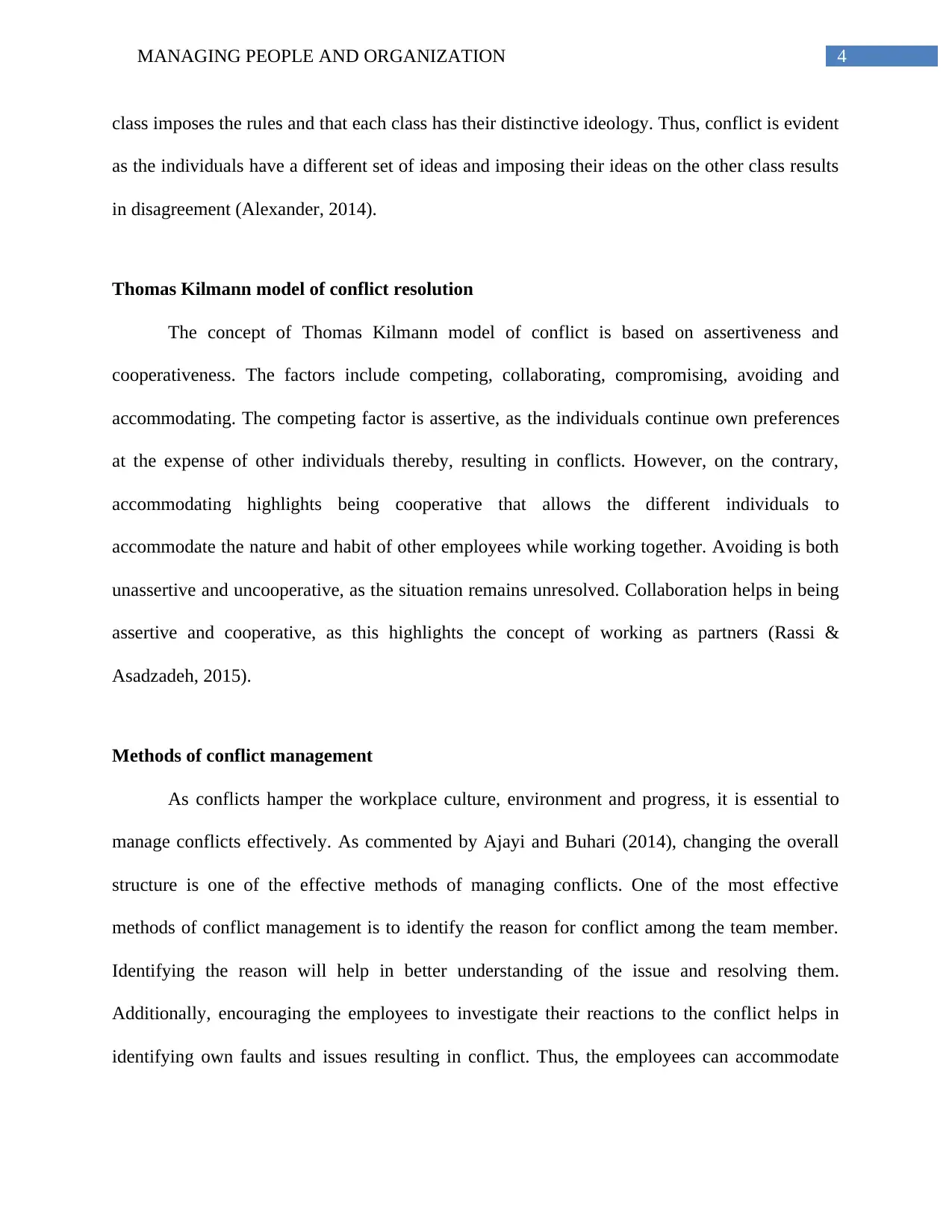
4MANAGING PEOPLE AND ORGANIZATION
class imposes the rules and that each class has their distinctive ideology. Thus, conflict is evident
as the individuals have a different set of ideas and imposing their ideas on the other class results
in disagreement (Alexander, 2014).
Thomas Kilmann model of conflict resolution
The concept of Thomas Kilmann model of conflict is based on assertiveness and
cooperativeness. The factors include competing, collaborating, compromising, avoiding and
accommodating. The competing factor is assertive, as the individuals continue own preferences
at the expense of other individuals thereby, resulting in conflicts. However, on the contrary,
accommodating highlights being cooperative that allows the different individuals to
accommodate the nature and habit of other employees while working together. Avoiding is both
unassertive and uncooperative, as the situation remains unresolved. Collaboration helps in being
assertive and cooperative, as this highlights the concept of working as partners (Rassi &
Asadzadeh, 2015).
Methods of conflict management
As conflicts hamper the workplace culture, environment and progress, it is essential to
manage conflicts effectively. As commented by Ajayi and Buhari (2014), changing the overall
structure is one of the effective methods of managing conflicts. One of the most effective
methods of conflict management is to identify the reason for conflict among the team member.
Identifying the reason will help in better understanding of the issue and resolving them.
Additionally, encouraging the employees to investigate their reactions to the conflict helps in
identifying own faults and issues resulting in conflict. Thus, the employees can accommodate
class imposes the rules and that each class has their distinctive ideology. Thus, conflict is evident
as the individuals have a different set of ideas and imposing their ideas on the other class results
in disagreement (Alexander, 2014).
Thomas Kilmann model of conflict resolution
The concept of Thomas Kilmann model of conflict is based on assertiveness and
cooperativeness. The factors include competing, collaborating, compromising, avoiding and
accommodating. The competing factor is assertive, as the individuals continue own preferences
at the expense of other individuals thereby, resulting in conflicts. However, on the contrary,
accommodating highlights being cooperative that allows the different individuals to
accommodate the nature and habit of other employees while working together. Avoiding is both
unassertive and uncooperative, as the situation remains unresolved. Collaboration helps in being
assertive and cooperative, as this highlights the concept of working as partners (Rassi &
Asadzadeh, 2015).
Methods of conflict management
As conflicts hamper the workplace culture, environment and progress, it is essential to
manage conflicts effectively. As commented by Ajayi and Buhari (2014), changing the overall
structure is one of the effective methods of managing conflicts. One of the most effective
methods of conflict management is to identify the reason for conflict among the team member.
Identifying the reason will help in better understanding of the issue and resolving them.
Additionally, encouraging the employees to investigate their reactions to the conflict helps in
identifying own faults and issues resulting in conflict. Thus, the employees can accommodate
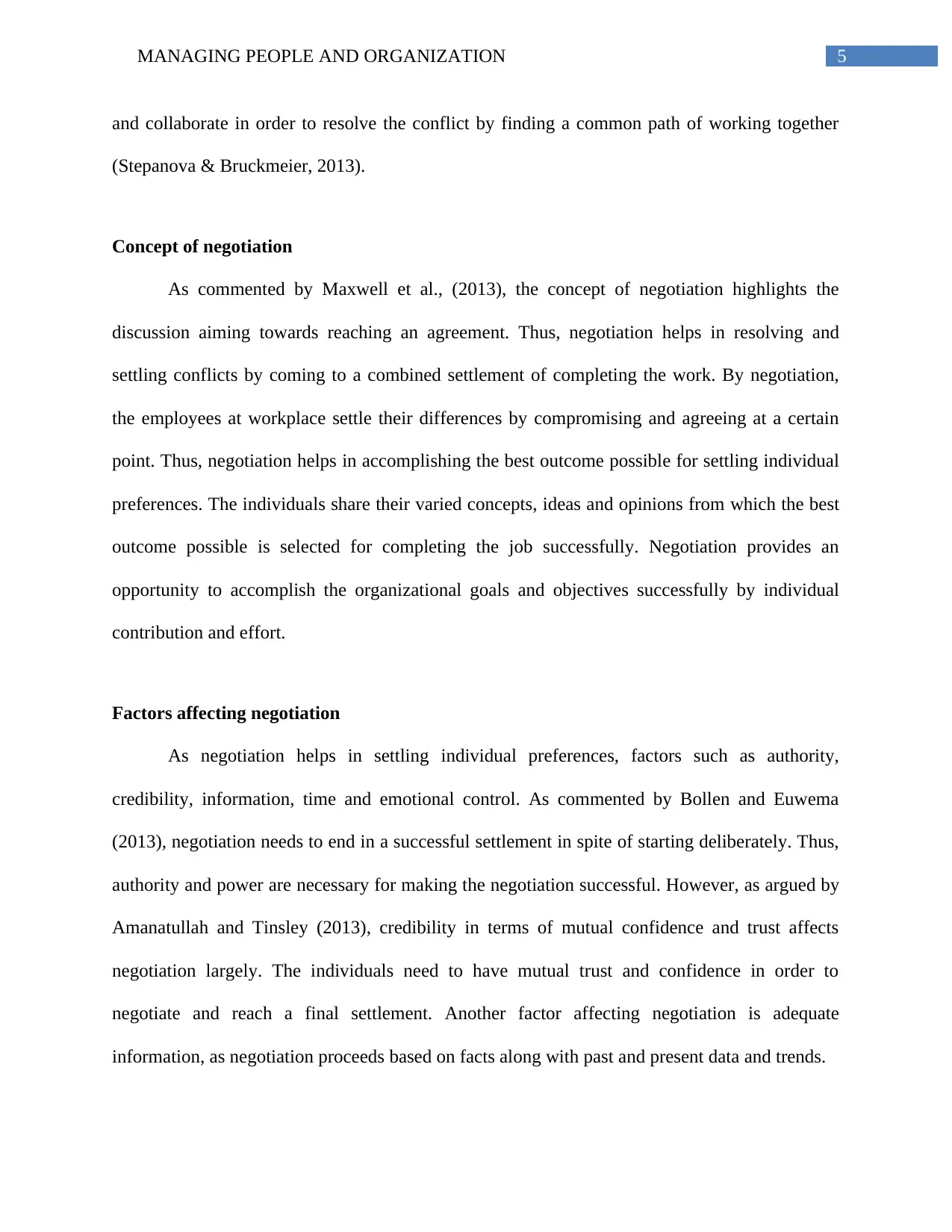
5MANAGING PEOPLE AND ORGANIZATION
and collaborate in order to resolve the conflict by finding a common path of working together
(Stepanova & Bruckmeier, 2013).
Concept of negotiation
As commented by Maxwell et al., (2013), the concept of negotiation highlights the
discussion aiming towards reaching an agreement. Thus, negotiation helps in resolving and
settling conflicts by coming to a combined settlement of completing the work. By negotiation,
the employees at workplace settle their differences by compromising and agreeing at a certain
point. Thus, negotiation helps in accomplishing the best outcome possible for settling individual
preferences. The individuals share their varied concepts, ideas and opinions from which the best
outcome possible is selected for completing the job successfully. Negotiation provides an
opportunity to accomplish the organizational goals and objectives successfully by individual
contribution and effort.
Factors affecting negotiation
As negotiation helps in settling individual preferences, factors such as authority,
credibility, information, time and emotional control. As commented by Bollen and Euwema
(2013), negotiation needs to end in a successful settlement in spite of starting deliberately. Thus,
authority and power are necessary for making the negotiation successful. However, as argued by
Amanatullah and Tinsley (2013), credibility in terms of mutual confidence and trust affects
negotiation largely. The individuals need to have mutual trust and confidence in order to
negotiate and reach a final settlement. Another factor affecting negotiation is adequate
information, as negotiation proceeds based on facts along with past and present data and trends.
and collaborate in order to resolve the conflict by finding a common path of working together
(Stepanova & Bruckmeier, 2013).
Concept of negotiation
As commented by Maxwell et al., (2013), the concept of negotiation highlights the
discussion aiming towards reaching an agreement. Thus, negotiation helps in resolving and
settling conflicts by coming to a combined settlement of completing the work. By negotiation,
the employees at workplace settle their differences by compromising and agreeing at a certain
point. Thus, negotiation helps in accomplishing the best outcome possible for settling individual
preferences. The individuals share their varied concepts, ideas and opinions from which the best
outcome possible is selected for completing the job successfully. Negotiation provides an
opportunity to accomplish the organizational goals and objectives successfully by individual
contribution and effort.
Factors affecting negotiation
As negotiation helps in settling individual preferences, factors such as authority,
credibility, information, time and emotional control. As commented by Bollen and Euwema
(2013), negotiation needs to end in a successful settlement in spite of starting deliberately. Thus,
authority and power are necessary for making the negotiation successful. However, as argued by
Amanatullah and Tinsley (2013), credibility in terms of mutual confidence and trust affects
negotiation largely. The individuals need to have mutual trust and confidence in order to
negotiate and reach a final settlement. Another factor affecting negotiation is adequate
information, as negotiation proceeds based on facts along with past and present data and trends.
⊘ This is a preview!⊘
Do you want full access?
Subscribe today to unlock all pages.

Trusted by 1+ million students worldwide
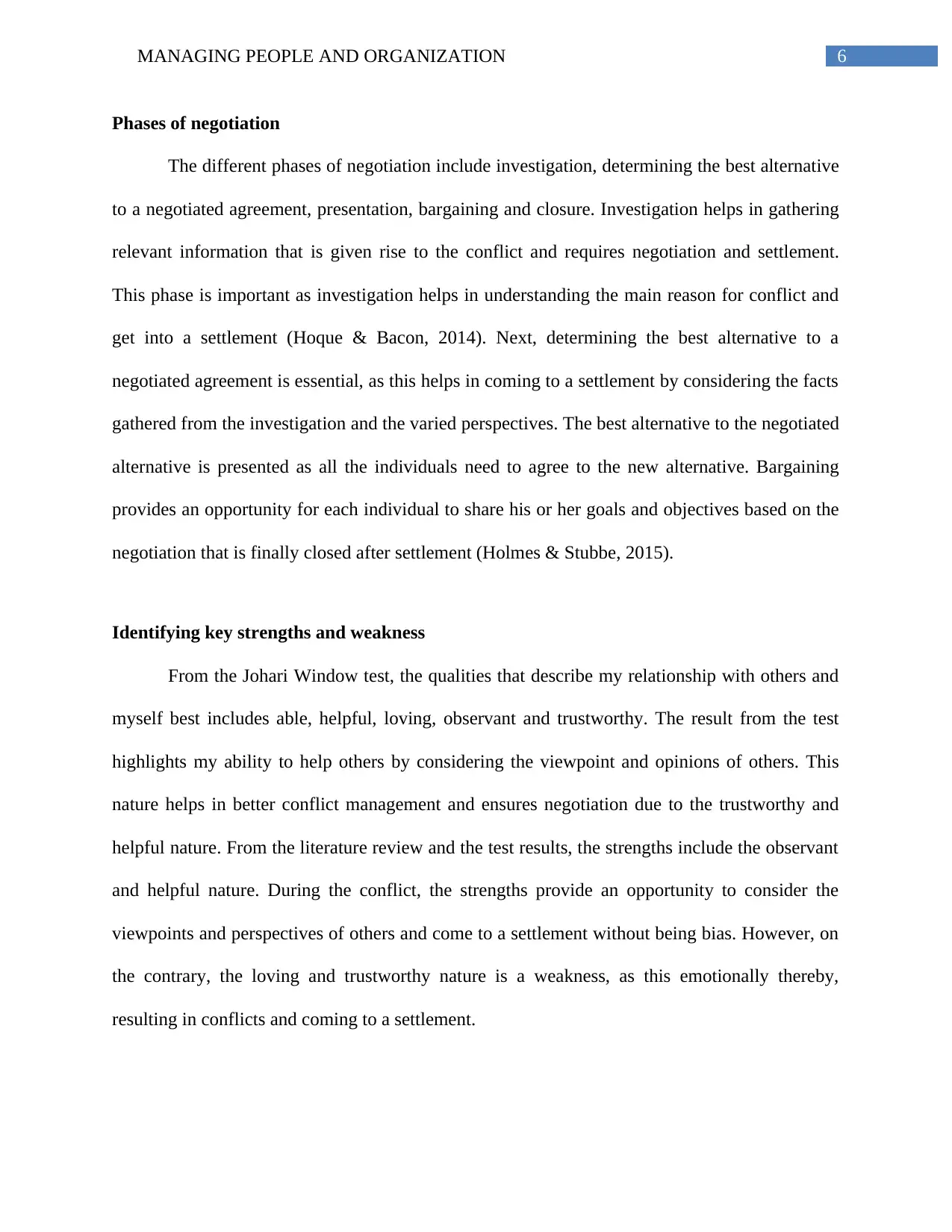
6MANAGING PEOPLE AND ORGANIZATION
Phases of negotiation
The different phases of negotiation include investigation, determining the best alternative
to a negotiated agreement, presentation, bargaining and closure. Investigation helps in gathering
relevant information that is given rise to the conflict and requires negotiation and settlement.
This phase is important as investigation helps in understanding the main reason for conflict and
get into a settlement (Hoque & Bacon, 2014). Next, determining the best alternative to a
negotiated agreement is essential, as this helps in coming to a settlement by considering the facts
gathered from the investigation and the varied perspectives. The best alternative to the negotiated
alternative is presented as all the individuals need to agree to the new alternative. Bargaining
provides an opportunity for each individual to share his or her goals and objectives based on the
negotiation that is finally closed after settlement (Holmes & Stubbe, 2015).
Identifying key strengths and weakness
From the Johari Window test, the qualities that describe my relationship with others and
myself best includes able, helpful, loving, observant and trustworthy. The result from the test
highlights my ability to help others by considering the viewpoint and opinions of others. This
nature helps in better conflict management and ensures negotiation due to the trustworthy and
helpful nature. From the literature review and the test results, the strengths include the observant
and helpful nature. During the conflict, the strengths provide an opportunity to consider the
viewpoints and perspectives of others and come to a settlement without being bias. However, on
the contrary, the loving and trustworthy nature is a weakness, as this emotionally thereby,
resulting in conflicts and coming to a settlement.
Phases of negotiation
The different phases of negotiation include investigation, determining the best alternative
to a negotiated agreement, presentation, bargaining and closure. Investigation helps in gathering
relevant information that is given rise to the conflict and requires negotiation and settlement.
This phase is important as investigation helps in understanding the main reason for conflict and
get into a settlement (Hoque & Bacon, 2014). Next, determining the best alternative to a
negotiated agreement is essential, as this helps in coming to a settlement by considering the facts
gathered from the investigation and the varied perspectives. The best alternative to the negotiated
alternative is presented as all the individuals need to agree to the new alternative. Bargaining
provides an opportunity for each individual to share his or her goals and objectives based on the
negotiation that is finally closed after settlement (Holmes & Stubbe, 2015).
Identifying key strengths and weakness
From the Johari Window test, the qualities that describe my relationship with others and
myself best includes able, helpful, loving, observant and trustworthy. The result from the test
highlights my ability to help others by considering the viewpoint and opinions of others. This
nature helps in better conflict management and ensures negotiation due to the trustworthy and
helpful nature. From the literature review and the test results, the strengths include the observant
and helpful nature. During the conflict, the strengths provide an opportunity to consider the
viewpoints and perspectives of others and come to a settlement without being bias. However, on
the contrary, the loving and trustworthy nature is a weakness, as this emotionally thereby,
resulting in conflicts and coming to a settlement.
Paraphrase This Document
Need a fresh take? Get an instant paraphrase of this document with our AI Paraphraser
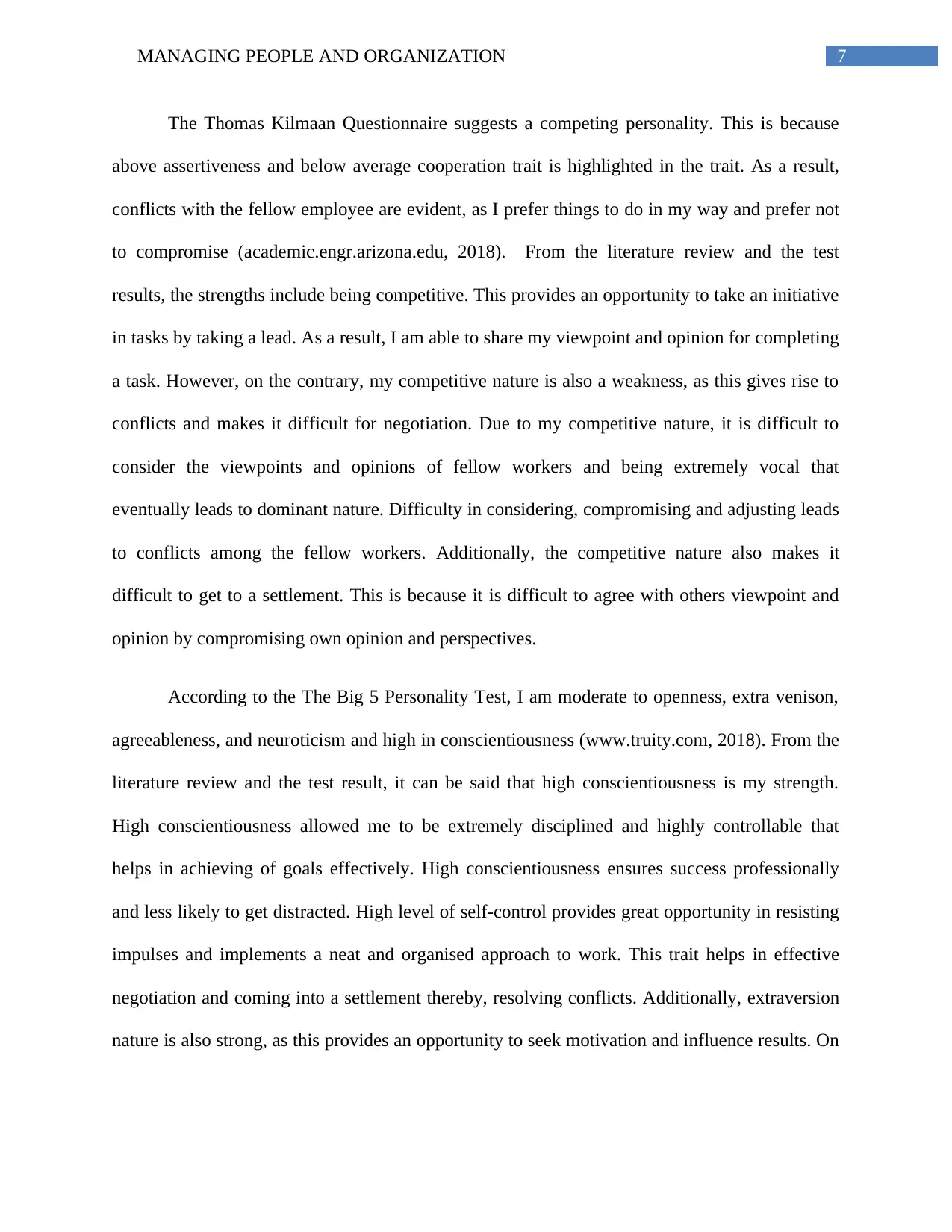
7MANAGING PEOPLE AND ORGANIZATION
The Thomas Kilmaan Questionnaire suggests a competing personality. This is because
above assertiveness and below average cooperation trait is highlighted in the trait. As a result,
conflicts with the fellow employee are evident, as I prefer things to do in my way and prefer not
to compromise (academic.engr.arizona.edu, 2018). From the literature review and the test
results, the strengths include being competitive. This provides an opportunity to take an initiative
in tasks by taking a lead. As a result, I am able to share my viewpoint and opinion for completing
a task. However, on the contrary, my competitive nature is also a weakness, as this gives rise to
conflicts and makes it difficult for negotiation. Due to my competitive nature, it is difficult to
consider the viewpoints and opinions of fellow workers and being extremely vocal that
eventually leads to dominant nature. Difficulty in considering, compromising and adjusting leads
to conflicts among the fellow workers. Additionally, the competitive nature also makes it
difficult to get to a settlement. This is because it is difficult to agree with others viewpoint and
opinion by compromising own opinion and perspectives.
According to the The Big 5 Personality Test, I am moderate to openness, extra venison,
agreeableness, and neuroticism and high in conscientiousness (www.truity.com, 2018). From the
literature review and the test result, it can be said that high conscientiousness is my strength.
High conscientiousness allowed me to be extremely disciplined and highly controllable that
helps in achieving of goals effectively. High conscientiousness ensures success professionally
and less likely to get distracted. High level of self-control provides great opportunity in resisting
impulses and implements a neat and organised approach to work. This trait helps in effective
negotiation and coming into a settlement thereby, resolving conflicts. Additionally, extraversion
nature is also strong, as this provides an opportunity to seek motivation and influence results. On
The Thomas Kilmaan Questionnaire suggests a competing personality. This is because
above assertiveness and below average cooperation trait is highlighted in the trait. As a result,
conflicts with the fellow employee are evident, as I prefer things to do in my way and prefer not
to compromise (academic.engr.arizona.edu, 2018). From the literature review and the test
results, the strengths include being competitive. This provides an opportunity to take an initiative
in tasks by taking a lead. As a result, I am able to share my viewpoint and opinion for completing
a task. However, on the contrary, my competitive nature is also a weakness, as this gives rise to
conflicts and makes it difficult for negotiation. Due to my competitive nature, it is difficult to
consider the viewpoints and opinions of fellow workers and being extremely vocal that
eventually leads to dominant nature. Difficulty in considering, compromising and adjusting leads
to conflicts among the fellow workers. Additionally, the competitive nature also makes it
difficult to get to a settlement. This is because it is difficult to agree with others viewpoint and
opinion by compromising own opinion and perspectives.
According to the The Big 5 Personality Test, I am moderate to openness, extra venison,
agreeableness, and neuroticism and high in conscientiousness (www.truity.com, 2018). From the
literature review and the test result, it can be said that high conscientiousness is my strength.
High conscientiousness allowed me to be extremely disciplined and highly controllable that
helps in achieving of goals effectively. High conscientiousness ensures success professionally
and less likely to get distracted. High level of self-control provides great opportunity in resisting
impulses and implements a neat and organised approach to work. This trait helps in effective
negotiation and coming into a settlement thereby, resolving conflicts. Additionally, extraversion
nature is also strong, as this provides an opportunity to seek motivation and influence results. On
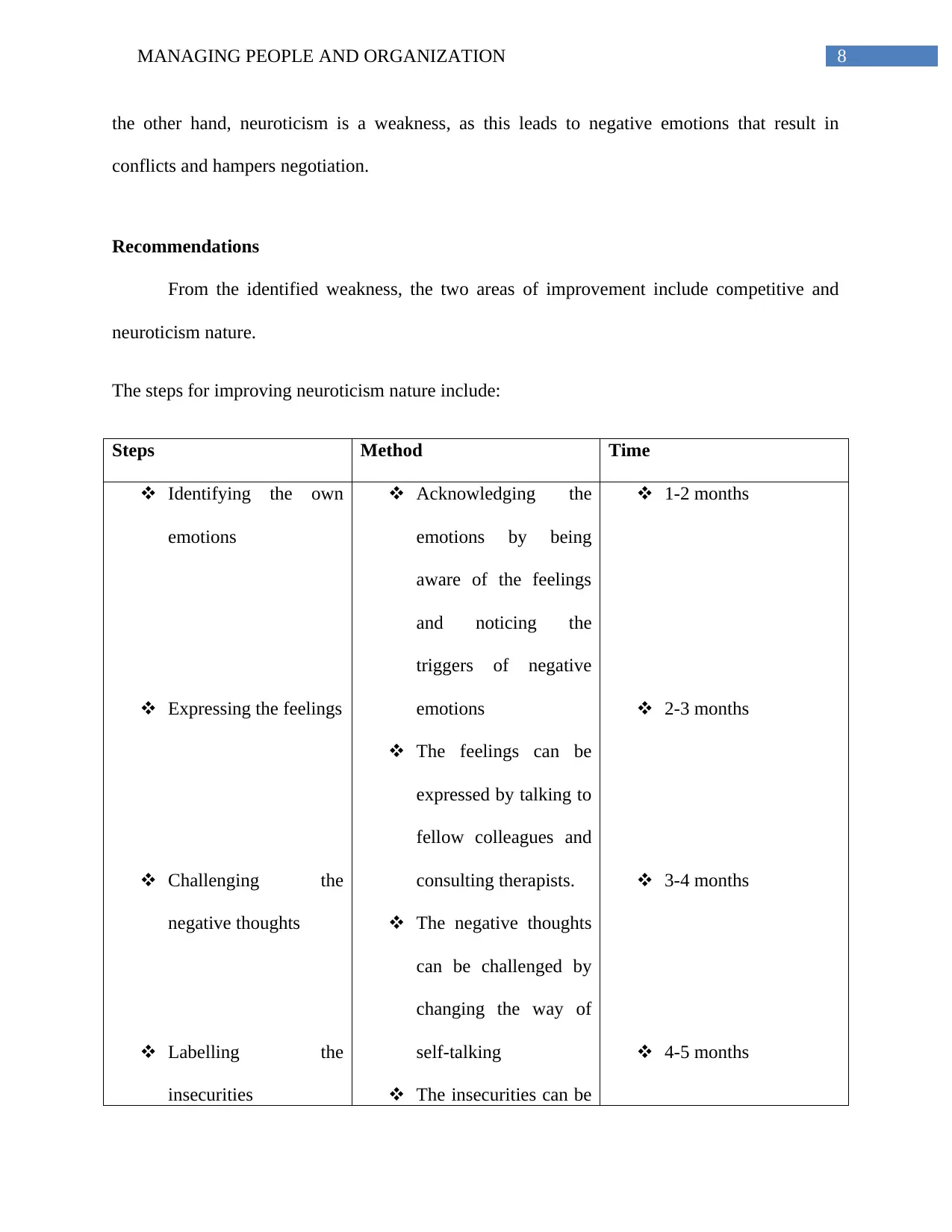
8MANAGING PEOPLE AND ORGANIZATION
the other hand, neuroticism is a weakness, as this leads to negative emotions that result in
conflicts and hampers negotiation.
Recommendations
From the identified weakness, the two areas of improvement include competitive and
neuroticism nature.
The steps for improving neuroticism nature include:
Steps Method Time
Identifying the own
emotions
Expressing the feelings
Challenging the
negative thoughts
Labelling the
insecurities
Acknowledging the
emotions by being
aware of the feelings
and noticing the
triggers of negative
emotions
The feelings can be
expressed by talking to
fellow colleagues and
consulting therapists.
The negative thoughts
can be challenged by
changing the way of
self-talking
The insecurities can be
1-2 months
2-3 months
3-4 months
4-5 months
the other hand, neuroticism is a weakness, as this leads to negative emotions that result in
conflicts and hampers negotiation.
Recommendations
From the identified weakness, the two areas of improvement include competitive and
neuroticism nature.
The steps for improving neuroticism nature include:
Steps Method Time
Identifying the own
emotions
Expressing the feelings
Challenging the
negative thoughts
Labelling the
insecurities
Acknowledging the
emotions by being
aware of the feelings
and noticing the
triggers of negative
emotions
The feelings can be
expressed by talking to
fellow colleagues and
consulting therapists.
The negative thoughts
can be challenged by
changing the way of
self-talking
The insecurities can be
1-2 months
2-3 months
3-4 months
4-5 months
⊘ This is a preview!⊘
Do you want full access?
Subscribe today to unlock all pages.

Trusted by 1+ million students worldwide
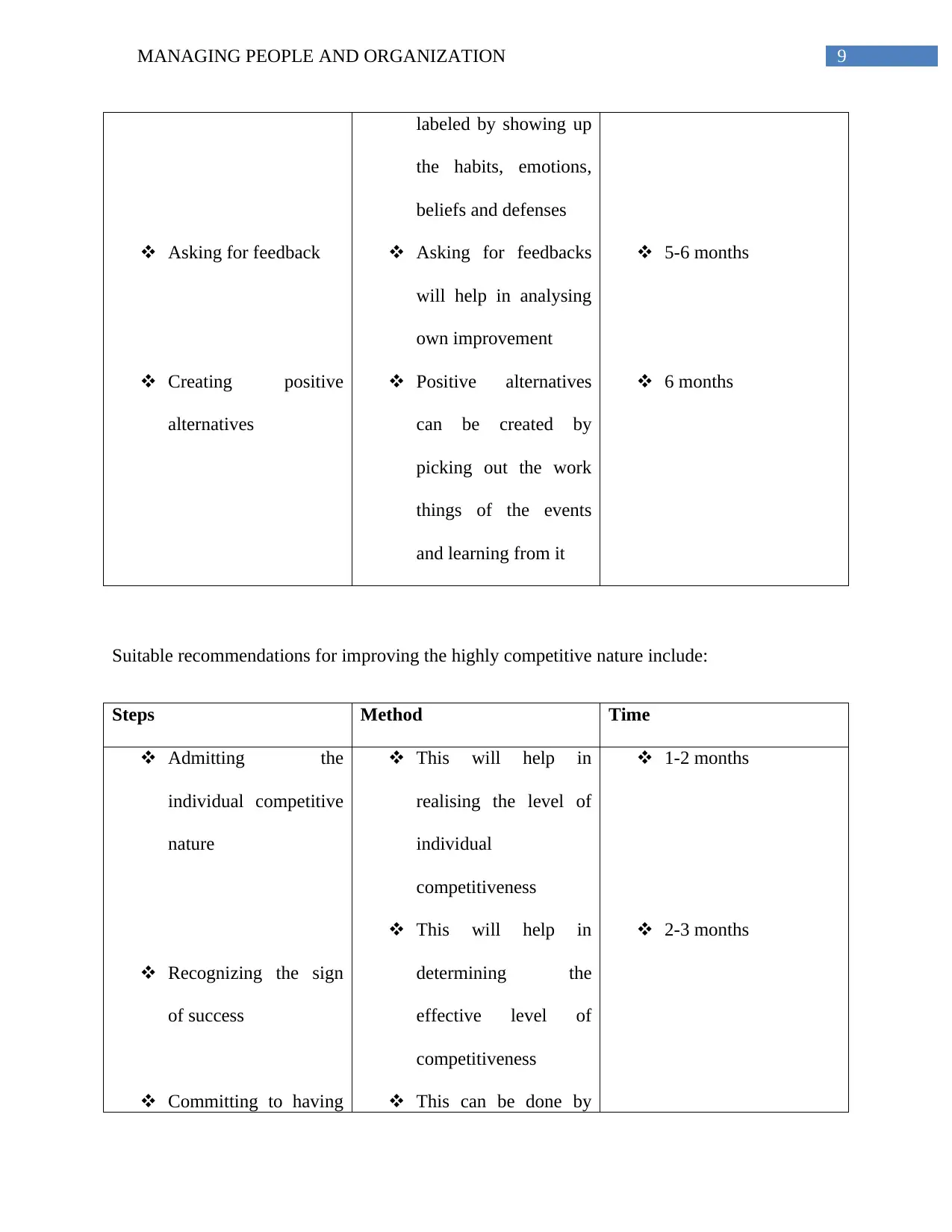
9MANAGING PEOPLE AND ORGANIZATION
Asking for feedback
Creating positive
alternatives
labeled by showing up
the habits, emotions,
beliefs and defenses
Asking for feedbacks
will help in analysing
own improvement
Positive alternatives
can be created by
picking out the work
things of the events
and learning from it
5-6 months
6 months
Suitable recommendations for improving the highly competitive nature include:
Steps Method Time
Admitting the
individual competitive
nature
Recognizing the sign
of success
Committing to having
This will help in
realising the level of
individual
competitiveness
This will help in
determining the
effective level of
competitiveness
This can be done by
1-2 months
2-3 months
Asking for feedback
Creating positive
alternatives
labeled by showing up
the habits, emotions,
beliefs and defenses
Asking for feedbacks
will help in analysing
own improvement
Positive alternatives
can be created by
picking out the work
things of the events
and learning from it
5-6 months
6 months
Suitable recommendations for improving the highly competitive nature include:
Steps Method Time
Admitting the
individual competitive
nature
Recognizing the sign
of success
Committing to having
This will help in
realising the level of
individual
competitiveness
This will help in
determining the
effective level of
competitiveness
This can be done by
1-2 months
2-3 months
Paraphrase This Document
Need a fresh take? Get an instant paraphrase of this document with our AI Paraphraser
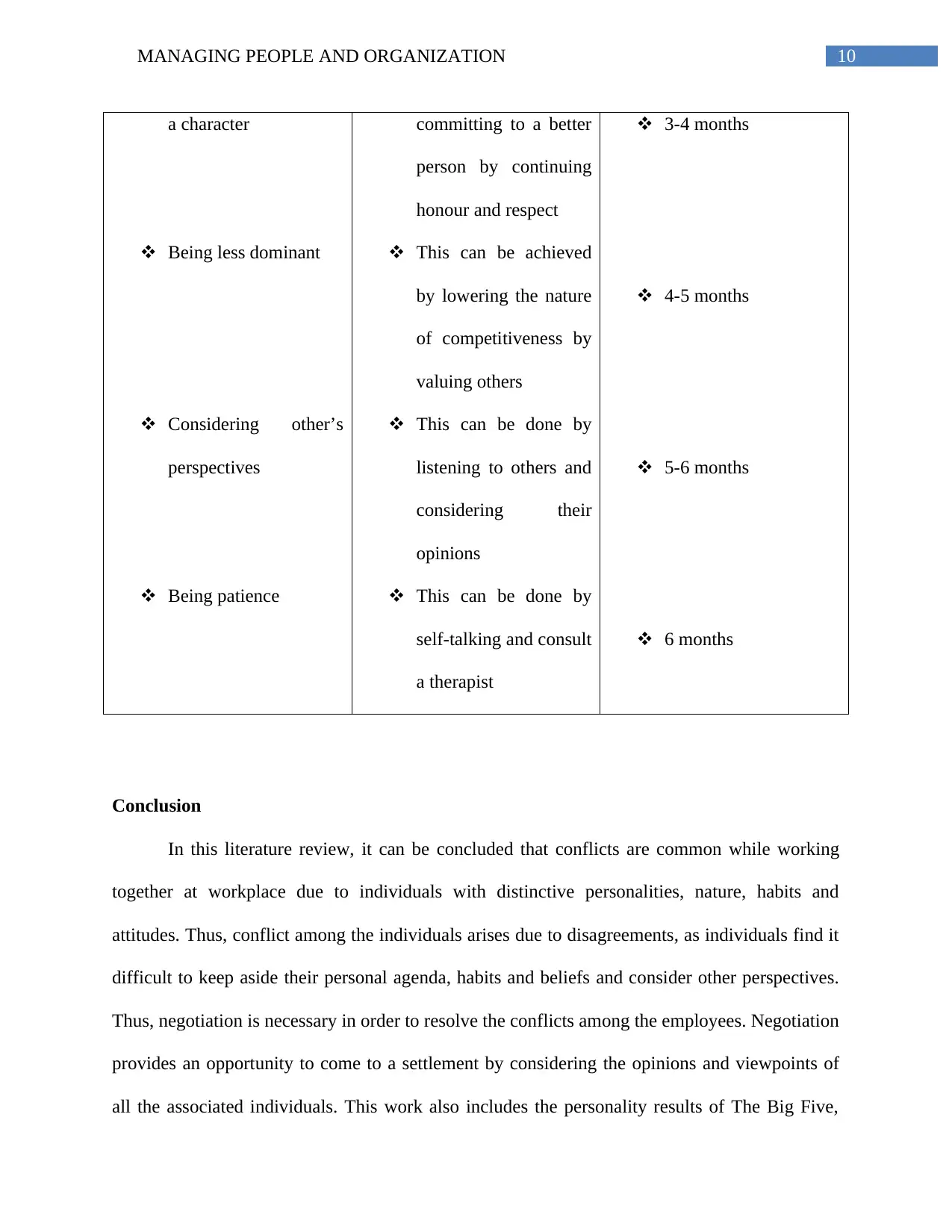
10MANAGING PEOPLE AND ORGANIZATION
a character
Being less dominant
Considering other’s
perspectives
Being patience
committing to a better
person by continuing
honour and respect
This can be achieved
by lowering the nature
of competitiveness by
valuing others
This can be done by
listening to others and
considering their
opinions
This can be done by
self-talking and consult
a therapist
3-4 months
4-5 months
5-6 months
6 months
Conclusion
In this literature review, it can be concluded that conflicts are common while working
together at workplace due to individuals with distinctive personalities, nature, habits and
attitudes. Thus, conflict among the individuals arises due to disagreements, as individuals find it
difficult to keep aside their personal agenda, habits and beliefs and consider other perspectives.
Thus, negotiation is necessary in order to resolve the conflicts among the employees. Negotiation
provides an opportunity to come to a settlement by considering the opinions and viewpoints of
all the associated individuals. This work also includes the personality results of The Big Five,
a character
Being less dominant
Considering other’s
perspectives
Being patience
committing to a better
person by continuing
honour and respect
This can be achieved
by lowering the nature
of competitiveness by
valuing others
This can be done by
listening to others and
considering their
opinions
This can be done by
self-talking and consult
a therapist
3-4 months
4-5 months
5-6 months
6 months
Conclusion
In this literature review, it can be concluded that conflicts are common while working
together at workplace due to individuals with distinctive personalities, nature, habits and
attitudes. Thus, conflict among the individuals arises due to disagreements, as individuals find it
difficult to keep aside their personal agenda, habits and beliefs and consider other perspectives.
Thus, negotiation is necessary in order to resolve the conflicts among the employees. Negotiation
provides an opportunity to come to a settlement by considering the opinions and viewpoints of
all the associated individuals. This work also includes the personality results of The Big Five,
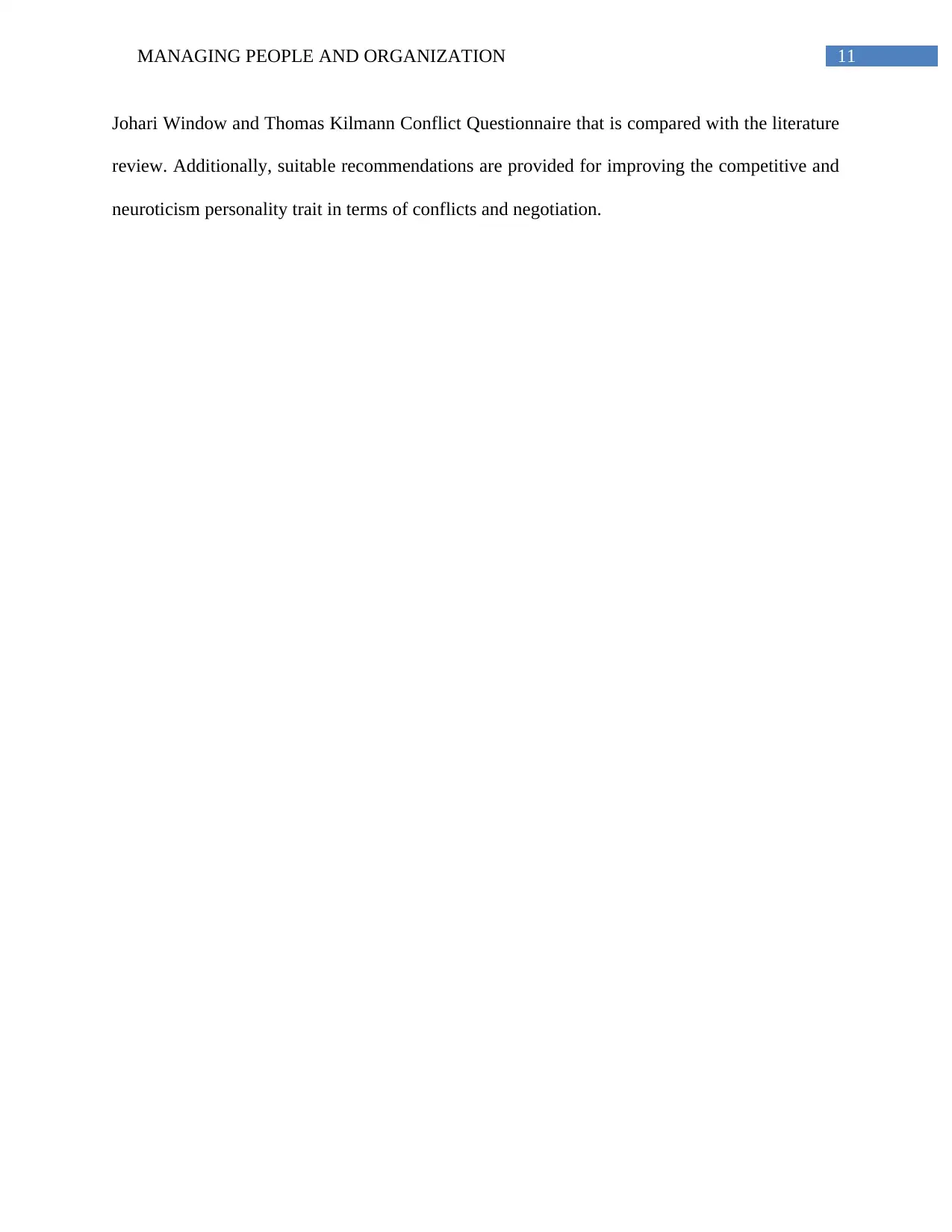
11MANAGING PEOPLE AND ORGANIZATION
Johari Window and Thomas Kilmann Conflict Questionnaire that is compared with the literature
review. Additionally, suitable recommendations are provided for improving the competitive and
neuroticism personality trait in terms of conflicts and negotiation.
Johari Window and Thomas Kilmann Conflict Questionnaire that is compared with the literature
review. Additionally, suitable recommendations are provided for improving the competitive and
neuroticism personality trait in terms of conflicts and negotiation.
⊘ This is a preview!⊘
Do you want full access?
Subscribe today to unlock all pages.

Trusted by 1+ million students worldwide
1 out of 14
Related Documents
Your All-in-One AI-Powered Toolkit for Academic Success.
+13062052269
info@desklib.com
Available 24*7 on WhatsApp / Email
![[object Object]](/_next/static/media/star-bottom.7253800d.svg)
Unlock your academic potential
Copyright © 2020–2025 A2Z Services. All Rights Reserved. Developed and managed by ZUCOL.




